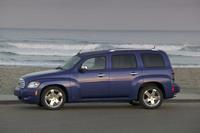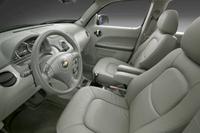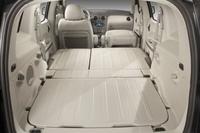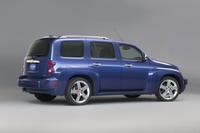2006 Chevrolet HHR LT Review
THE AUTO PAGE
By
JOHN HEILIG
SEE ALSO: New Car Buyer's Guide for Chevrolet
SPECIFICATIONSMODEL: Chevrolet HHR LT
ENGINE: 2.4-liter L4
HORSEPOWER/TORQUE: 172 hp @ 6200 rpm/162 lb.-ft. @ 5000 rpm
TRANSMISSION: 5-speed manual
WHEELBASE: 103.5 in.
LENGTH x WIDTH x HEIGHT: 17602 x 69.2 x 65.2 in.
TIRES: P215/55R16 all-season
CARGO VOLUME: 63.1 cu. ft.
ECONOMY: 22 mpg city/30 mpg highway/24.1 mpg test
PRICE: $$19,030 (includes $565 destination charge)
Obviously a take-off on the Chrysler PT Cruiser, the Chevrolet HHR compact car has a charm of its own. The PT Cruiser and HHR are very similar vehicles, with nearly identical engines, nearly identical dimensions, and nearly identical performance. Both are built in Mexico. Which one you choose is exclusively in the eye of the beholder.
Like the PT Cruiser, the HHR is built on a compact car platform, in this case the Cobalt/Cavalier. It is front-wheel drive and solid, with few rattles. We had an opportunity to drive one in a weeklong test as well as a "quickie" drive at the northeast introduction. Both vehicles were solid and gave the impression that all the bolts were tightened and all the welds secure. This isn't something you'll always find in a compact car, no matter where it's built.
Under the stubby hood is a 2.4-liter inline four-cylinder engine rated at 172 horsepower. This is plenty of power for the 3100-pound HHR. Any more power would be useless. Power reaches the front wheels through a 5-speed manual transmission. Actually, this is the reason I received the HHR a week before it was scheduled. It seems another local automotive journalist who writes for a large daily newspaper can't drive a manual transmission car, so the car that was scheduled for him was bumped to me. Thanks.
The shifter is topped by a neat chrome ball, just as it should be in a hot rod-style vehicle. One of my few complaints with the HHR was that I felt the shifter itself was about two to three inches too short. It wasn't really a problem, although it was exacerbated with the driver's fold-down armrest in place. I felt the gearbox was well gated and the gears were easy to find. I felt that the HHR was most comfortable in fourth gear in normal driving, in fifth on the highway.
In front of the driver is a neat instrument panel. The instruments are white-on-black, my personal favorite. There's a multi-function gauge to the left housing the water temperature and fuel level gauges. The large speedometer in the middle has a smaller tachometer placed so that it overlaps and gives a three-dimensional effect.
HVAC vents on the dash itself can be closed completely, similar to the new Mustang, so there's a neater, flat appearance.
Cruise control switches are located in the steering wheel, which is a new style for GM cars. In addition, there's an information system switch. The info system told us about fuel economy, oil life, fuel range, etc.
Power window switches are located at the base of the center stack, not my favorite location. While they're clearly labeled, you have to stretch a bit to reach them. It does take a while to pick the right window to open, but even with my shallow learning curve I figured it out. The seats offer little side support. Normally I would whine about this, but the HHR really isn't a sports car, so you're not going to go zipping around corners at speeds that would require better side support. They were comfortable, though.
Rear legroom is tight, especially with the front seats pushed back. However, one of the charms of this type of vehicle is enormous headroom, so you can sit more erectly to reduce the need for greater legroom and not hit your head on the roof. There's only one cup holder for rear passengers, two up front.
Despite more than 63 cubic feet of cargo volume (with the rear seats folded), it's always nice to find smaller storage areas in the cockpit that are more accessible. The HHR has a couple, including a neat tray on the top of the dash that's covered and deep. Even with the top up, forward visibility isn't impeded.
The rear cargo area has several configurations. There's a tray, or shelf, that can be kept flat on the floor or lifted to a midway position, creating a two-level storage area. There are also bins underneath that can stow smaller items.
Personally, I think I would keep the rear seats folded and use the HHR as a two-passenger station wagon. There would be plenty of room for golf bags, but only two golfers would travel to the course.
Our audio system consisted of an AM/FM/CD/XM stereo system. However, the XM wasn't hooked up, much to my dismay.
The HVAC system was excellent. We had the HHR during one of the early cold snaps, and the heater really pumped out the calories.
We had the uplevel LT version. There's an LS version that's $1,000 cheaper, with a base price of $16,425. Among the options on our tester were the 2.4-liter engine (as opposed to the base 2.2-liter) ($650), 4-wheel anti-lock brakes ($400), side curtain air bags ($395), and roof luggage rails ($150). Color-keyed running boards$445) were a dealer-installed option.
As I said at the top, the choice between the HHR and the PT Cruiser are in the eye of the beholder. We'll bet the HHR attracts a lot of buyers.
© 2005 The Auto Page Syndicate
COMPARE HHR V. PT Cruiser Head 2Head






